03. SPI 控制器驱动分析
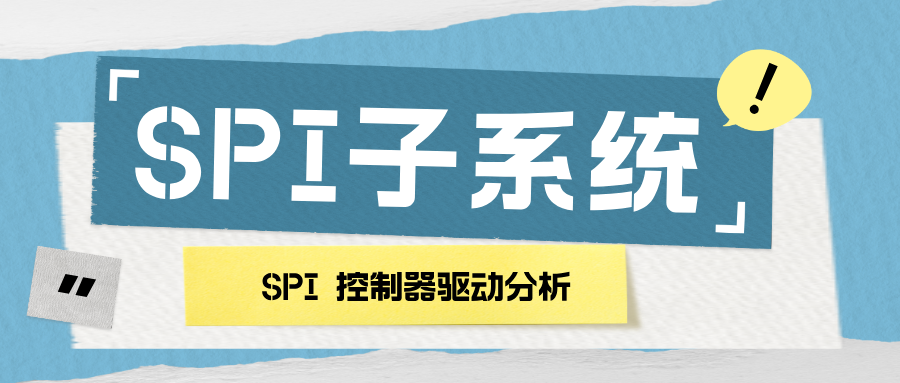
一、设备树

-->platform_device
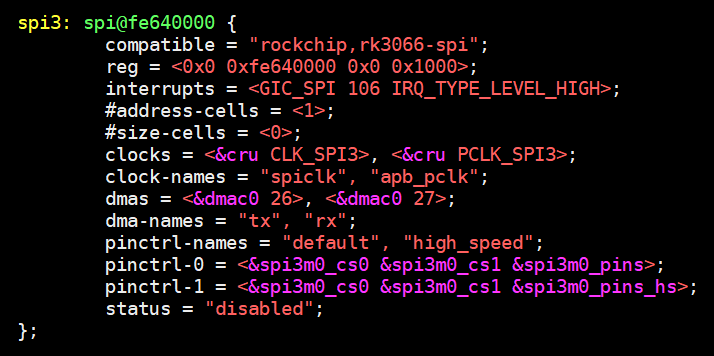
其中需要注意pinctrl信息是否是我们需要的。
二、控制器驱动
/kernel/drivers/spi$ vim spi-rockchip.c
-->platform_driver
2.1、平台的注册

2.2、probe函数
- 获取设备树资源
- 向上层提供设备的操作函数接口(数据传输接口:transfer_one实现)
- 向内核添加设备(顺便把挂在控制器上面的spidev进行注册)
瑞芯微的私有结构体,做记录用,后续数据传输使用:
struct rockchip_spi {
struct device *dev;
struct clk *spiclk;
struct clk *apb_pclk;
void __iomem *regs;
dma_addr_t dma_addr_rx;
dma_addr_t dma_addr_tx;
const void *tx;
void *rx;
unsigned int tx_left;
unsigned int rx_left;
atomic_t state;
/*depth of the FIFO buffer */
u32 fifo_len;
/* frequency of spiclk */
u32 freq;
u8 n_bytes;
u8 rsd;
bool cs_asserted[ROCKCHIP_SPI_MAX_CS_NUM];
struct pinctrl_state *high_speed_state;
bool slave_abort;
bool gpio_requested;
bool cs_inactive; /* spi slave tansmition stop when cs inactive */
struct spi_transfer *xfer; /* Store xfer temporarily */
spinlock_t lock; /* prevent I/O concurrent access */
};2
3
4
5
6
7
8
9
10
11
12
13
14
15
16
17
18
19
20
21
22
23
24
25
26
27
28
29
30
31
32
33
34
static int rockchip_spi_probe(struct platform_device *pdev)
{
int ret;
struct rockchip_spi *rs;
struct spi_controller *ctlr;
struct resource *mem;
struct device_node *np = pdev->dev.of_node;
u32 rsd_nsecs;
bool slave_mode;
struct pinctrl *pinctrl = NULL;
// 判断当前控制的模式
slave_mode = of_property_read_bool(np, "spi-slave");
if (slave_mode)
ctlr = spi_alloc_slave(&pdev->dev,
sizeof(struct rockchip_spi));
else
ctlr = spi_alloc_master(&pdev->dev,
sizeof(struct rockchip_spi));
//在platform_device 记录 master
platform_set_drvdata(pdev, ctlr);
//获取master data
rs = spi_controller_get_devdata(ctlr);
ctlr->slave = slave_mode;
//对寄存器的映射
/* Get basic io resource and map it */
mem = platform_get_resource(pdev, IORESOURCE_MEM, 0);
rs->regs = devm_ioremap_resource(&pdev->dev, mem);
if (IS_ERR(rs->regs)) {
ret = PTR_ERR(rs->regs);
goto err_put_ctlr;
}
//自旋锁的初始胡
spin_lock_init(&rs->lock);
//时钟的使能
rs->apb_pclk = devm_clk_get(&pdev->dev, "apb_pclk");
if (IS_ERR(rs->apb_pclk)) {
dev_err(&pdev->dev, "Failed to get apb_pclk\n");
ret = PTR_ERR(rs->apb_pclk);
goto err_put_ctlr;
}
rs->spiclk = devm_clk_get(&pdev->dev, "spiclk");
if (IS_ERR(rs->spiclk)) {
dev_err(&pdev->dev, "Failed to get spi_pclk\n");
ret = PTR_ERR(rs->spiclk);
goto err_put_ctlr;
}
ret = clk_prepare_enable(rs->apb_pclk);
if (ret < 0) {
dev_err(&pdev->dev, "Failed to enable apb_pclk\n");
goto err_put_ctlr;
}
ret = clk_prepare_enable(rs->spiclk);
if (ret < 0) {
dev_err(&pdev->dev, "Failed to enable spi_clk\n");
goto err_disable_apbclk;
}
spi_enable_chip(rs, false);
//中断的注册
ret = platform_get_irq(pdev, 0);
if (ret < 0)
goto err_disable_spiclk;
ret = devm_request_threaded_irq(&pdev->dev, ret, rockchip_spi_isr, NULL,
IRQF_ONESHOT, dev_name(&pdev->dev), ctlr);
if (ret)
goto err_disable_spiclk;
rs->dev = &pdev->dev;
rs->freq = clk_get_rate(rs->spiclk);
rs->gpio_requested = false;
if (!of_property_read_u32(pdev->dev.of_node, "rx-sample-delay-ns",
&rsd_nsecs)) {
/* rx sample delay is expressed in parent clock cycles (max 3) */
u32 rsd = DIV_ROUND_CLOSEST(rsd_nsecs * (rs->freq >> 8),
1000000000 >> 8);
if (!rsd) {
dev_warn(rs->dev, "%u Hz are too slow to express %u ns delay\n",
rs->freq, rsd_nsecs);
} else if (rsd > CR0_RSD_MAX) {
rsd = CR0_RSD_MAX;
dev_warn(rs->dev, "%u Hz are too fast to express %u ns delay, clamping at %u ns\n",
rs->freq, rsd_nsecs,
CR0_RSD_MAX * 1000000000U / rs->freq);
}
rs->rsd = rsd;
}
//休眠唤醒机制
pm_runtime_set_active(&pdev->dev);
pm_runtime_enable(&pdev->dev);
//spi_control 结构体的填充
ctlr->auto_runtime_pm = true;
ctlr->bus_num = pdev->id;
ctlr->mode_bits = SPI_CPOL | SPI_CPHA | SPI_LOOP | SPI_LSB_FIRST | SPI_CS_HIGH;
if (slave_mode) {
ctlr->mode_bits |= SPI_NO_CS;
ctlr->slave_abort = rockchip_spi_slave_abort;
} else {
ctlr->flags = SPI_MASTER_GPIO_SS;
}
ctlr->num_chipselect = ROCKCHIP_SPI_MAX_CS_NUM;
ctlr->dev.of_node = pdev->dev.of_node;
ctlr->bits_per_word_mask = SPI_BPW_MASK(16) | SPI_BPW_MASK(8) | SPI_BPW_MASK(4);
ctlr->min_speed_hz = rs->freq / BAUDR_SCKDV_MAX;
ctlr->max_speed_hz = min(rs->freq / BAUDR_SCKDV_MIN, MAX_SCLK_OUT);
ctlr->set_cs = rockchip_spi_set_cs;
ctlr->setup = rockchip_spi_setup;
ctlr->cleanup = rockchip_spi_cleanup;
ctlr->transfer_one = rockchip_spi_transfer_one;
ctlr->max_transfer_size = rockchip_spi_max_transfer_size;
ctlr->handle_err = rockchip_spi_handle_err;
ctlr->dma_tx = dma_request_chan(rs->dev, "tx");
//获取GPIO第二状态,休眠时候会用到
pinctrl = devm_pinctrl_get(&pdev->dev);
if (!IS_ERR(pinctrl)) {
rs->high_speed_state = pinctrl_lookup_state(pinctrl, "high_speed");
if (IS_ERR_OR_NULL(rs->high_speed_state)) {
dev_warn(&pdev->dev, "no high_speed pinctrl state\n");
rs->high_speed_state = NULL;
}
}
//控制器注册
ret = devm_spi_register_controller(&pdev->dev, ctlr);
if (ret < 0) {
dev_err(&pdev->dev, "Failed to register controller\n");
goto err_free_dma_rx;
}
return 0;2
3
4
5
6
7
8
9
10
11
12
13
14
15
16
17
18
19
20
21
22
23
24
25
26
27
28
29
30
31
32
33
34
35
36
37
38
39
40
41
42
43
44
45
46
47
48
49
50
51
52
53
54
55
56
57
58
59
60
61
62
63
64
65
66
67
68
69
70
71
72
73
74
75
76
77
78
79
80
81
82
83
84
85
86
87
88
89
90
91
92
93
94
95
96
97
98
99
100
101
102
103
104
105
106
107
108
109
110
111
112
113
114
115
116
117
118
119
120
121
122
123
124
125
126
127
128
129
130
131
132
133
134
135
136
137
138
139
140
141
142
143
144
145
146
147
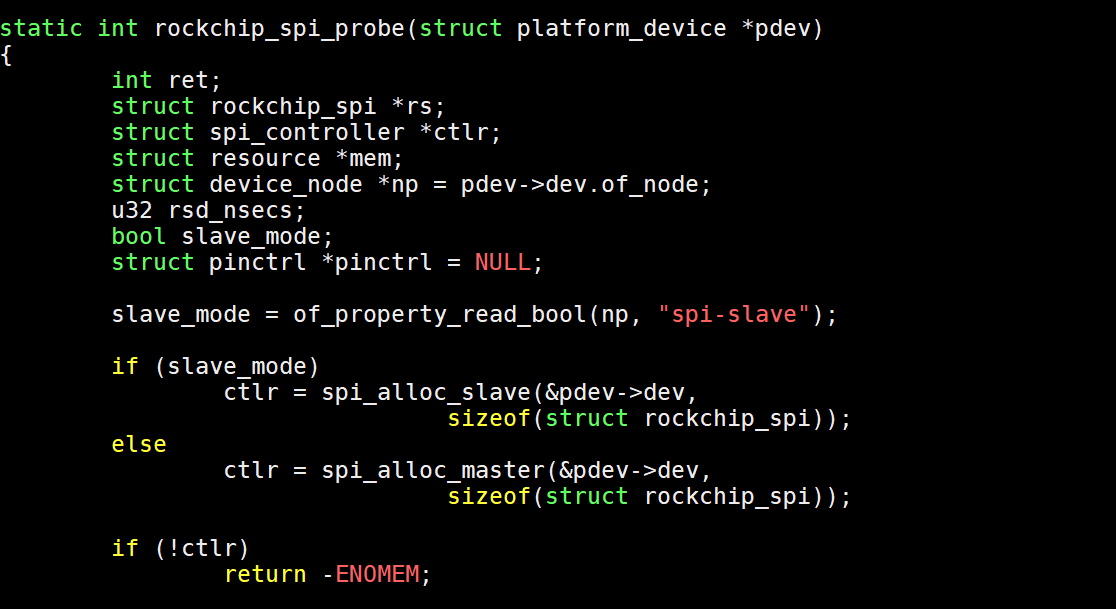
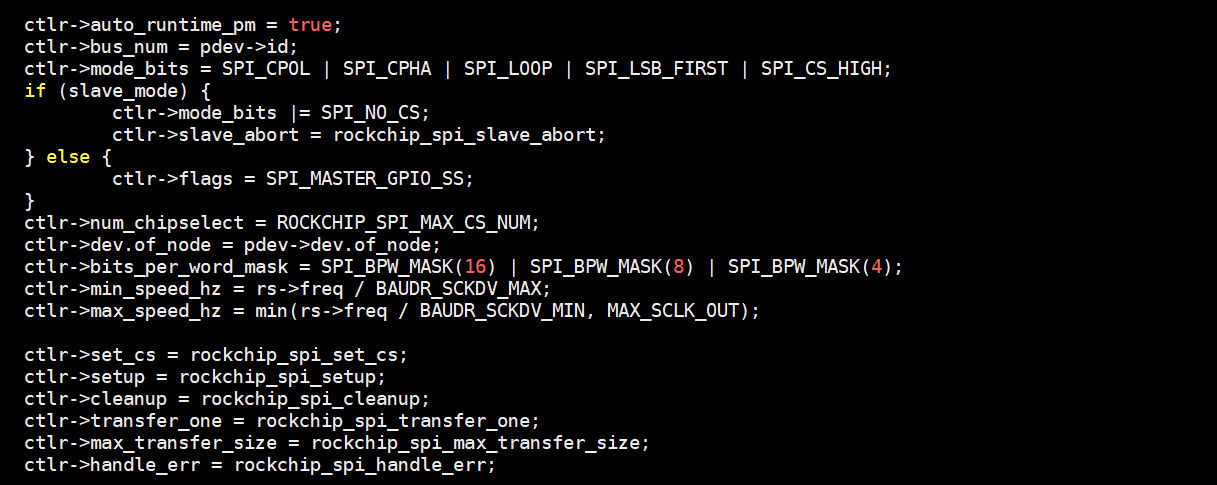
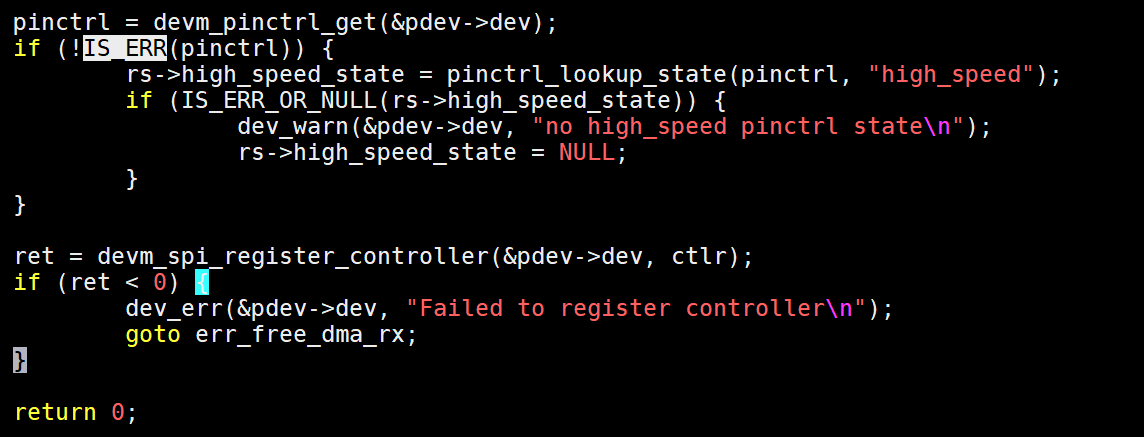
三、控制器驱动结构体
linux/spi/spi.h
最新的内核代码中使用 spi_controller (以前是 spi_master 结构)来描述一个SPI的控制器
/**
* struct spi_controller - interface to SPI master or slave controller
* @dev: device interface to this driver
* @list: link with the global spi_controller list
* @bus_num: board-specific (and often SoC-specific) identifier for a
* given SPI controller.
* @num_chipselect: chipselects are used to distinguish individual
* SPI slaves, and are numbered from zero to num_chipselects.
* each slave has a chipselect signal, but it's common that not
* every chipselect is connected to a slave.
* @dma_alignment: SPI controller constraint on DMA buffers alignment.
* @mode_bits: flags understood by this controller driver
* @bits_per_word_mask: A mask indicating which values of bits_per_word are
* supported by the driver. Bit n indicates that a bits_per_word n+1 is
* supported. If set, the SPI core will reject any transfer with an
* unsupported bits_per_word. If not set, this value is simply ignored,
* and it's up to the individual driver to perform any validation.
* @min_speed_hz: Lowest supported transfer speed
* @max_speed_hz: Highest supported transfer speed
* @flags: other constraints relevant to this driver
* @slave: indicates that this is an SPI slave controller
* @max_transfer_size: function that returns the max transfer size for
* a &spi_device; may be %NULL, so the default %SIZE_MAX will be used.
* @max_message_size: function that returns the max message size for
* a &spi_device; may be %NULL, so the default %SIZE_MAX will be used.
* @io_mutex: mutex for physical bus access
* @bus_lock_spinlock: spinlock for SPI bus locking
* @bus_lock_mutex: mutex for exclusion of multiple callers
* @bus_lock_flag: indicates that the SPI bus is locked for exclusive use
* @setup: updates the device mode and clocking records used by a
* device's SPI controller; protocol code may call this. This
* must fail if an unrecognized or unsupported mode is requested.
* It's always safe to call this unless transfers are pending on
* the device whose settings are being modified.
* @set_cs_timing: optional hook for SPI devices to request SPI master
* controller for configuring specific CS setup time, hold time and inactive
* delay interms of clock counts
* @transfer: adds a message to the controller's transfer queue.
* @cleanup: frees controller-specific state
* @can_dma: determine whether this controller supports DMA
* @queued: whether this controller is providing an internal message queue
* @kworker: thread struct for message pump
* @kworker_task: pointer to task for message pump kworker thread
* @pump_messages: work struct for scheduling work to the message pump
* @queue_lock: spinlock to syncronise access to message queue
* @queue: message queue
* @idling: the device is entering idle state
* @cur_msg: the currently in-flight message
* @cur_msg_prepared: spi_prepare_message was called for the currently
* in-flight message
* @cur_msg_mapped: message has been mapped for DMA
* @xfer_completion: used by core transfer_one_message()
* @busy: message pump is busy
* @running: message pump is running
* @rt: whether this queue is set to run as a realtime task
* @auto_runtime_pm: the core should ensure a runtime PM reference is held
* while the hardware is prepared, using the parent
* device for the spidev
* @max_dma_len: Maximum length of a DMA transfer for the device.
* @prepare_transfer_hardware: a message will soon arrive from the queue
* so the subsystem requests the driver to prepare the transfer hardware
* by issuing this call
* @transfer_one_message: the subsystem calls the driver to transfer a single
* message while queuing transfers that arrive in the meantime. When the
* driver is finished with this message, it must call
* spi_finalize_current_message() so the subsystem can issue the next
* message
* @unprepare_transfer_hardware: there are currently no more messages on the
* queue so the subsystem notifies the driver that it may relax the
* hardware by issuing this call
*
* @set_cs: set the logic level of the chip select line. May be called
* from interrupt context.
* @prepare_message: set up the controller to transfer a single message,
* for example doing DMA mapping. Called from threaded
* context.
* @transfer_one: transfer a single spi_transfer.
* - return 0 if the transfer is finished,
* - return 1 if the transfer is still in progress. When
* the driver is finished with this transfer it must
* call spi_finalize_current_transfer() so the subsystem
* can issue the next transfer. Note: transfer_one and
* transfer_one_message are mutually exclusive; when both
* are set, the generic subsystem does not call your
* transfer_one callback.
* @handle_err: the subsystem calls the driver to handle an error that occurs
* in the generic implementation of transfer_one_message().
* @mem_ops: optimized/dedicated operations for interactions with SPI memory.
* This field is optional and should only be implemented if the
* controller has native support for memory like operations.
* @unprepare_message: undo any work done by prepare_message().
* @slave_abort: abort the ongoing transfer request on an SPI slave controller
* @cs_gpios: LEGACY: array of GPIO descs to use as chip select lines; one per
* CS number. Any individual value may be -ENOENT for CS lines that
* are not GPIOs (driven by the SPI controller itself). Use the cs_gpiods
* in new drivers.
* @cs_gpiods: Array of GPIO descs to use as chip select lines; one per CS
* number. Any individual value may be NULL for CS lines that
* are not GPIOs (driven by the SPI controller itself).
* @use_gpio_descriptors: Turns on the code in the SPI core to parse and grab
* GPIO descriptors rather than using global GPIO numbers grabbed by the
* driver. This will fill in @cs_gpiods and @cs_gpios should not be used,
* and SPI devices will have the cs_gpiod assigned rather than cs_gpio.
* @statistics: statistics for the spi_controller
* @dma_tx: DMA transmit channel
* @dma_rx: DMA receive channel
* @dummy_rx: dummy receive buffer for full-duplex devices
* @dummy_tx: dummy transmit buffer for full-duplex devices
* @fw_translate_cs: If the boot firmware uses different numbering scheme
* what Linux expects, this optional hook can be used to translate
* between the two.
*
* Each SPI controller can communicate with one or more @spi_device
* children. These make a small bus, sharing MOSI, MISO and SCK signals
* but not chip select signals. Each device may be configured to use a
* different clock rate, since those shared signals are ignored unless
* the chip is selected.
*
* The driver for an SPI controller manages access to those devices through
* a queue of spi_message transactions, copying data between CPU memory and
* an SPI slave device. For each such message it queues, it calls the
* message's completion function when the transaction completes.
*/
struct spi_controller {
struct device dev;
struct list_head list;
/* other than negative (== assign one dynamically), bus_num is fully
* board-specific. usually that simplifies to being SoC-specific.
* example: one SoC has three SPI controllers, numbered 0..2,
* and one board's schematics might show it using SPI-2. software
* would normally use bus_num=2 for that controller.
*/
s16 bus_num;
/* chipselects will be integral to many controllers; some others
* might use board-specific GPIOs.
*/
u16 num_chipselect;
/* some SPI controllers pose alignment requirements on DMAable
* buffers; let protocol drivers know about these requirements.
*/
u16 dma_alignment;
/* spi_device.mode flags understood by this controller driver */
u32 mode_bits;
/* bitmask of supported bits_per_word for transfers */
u32 bits_per_word_mask;
#define SPI_BPW_MASK(bits) BIT((bits) - 1)
#define SPI_BPW_RANGE_MASK(min, max) GENMASK((max) - 1, (min) - 1)
/* limits on transfer speed */
u32 min_speed_hz;
u32 max_speed_hz;
/* other constraints relevant to this driver */
u16 flags;
#define SPI_CONTROLLER_HALF_DUPLEX BIT(0) /* can't do full duplex */
#define SPI_CONTROLLER_NO_RX BIT(1) /* can't do buffer read */
#define SPI_CONTROLLER_NO_TX BIT(2) /* can't do buffer write */
#define SPI_CONTROLLER_MUST_RX BIT(3) /* requires rx */
#define SPI_CONTROLLER_MUST_TX BIT(4) /* requires tx */
#define SPI_MASTER_GPIO_SS BIT(5) /* GPIO CS must select slave */
/* flag indicating this is an SPI slave controller */
bool slave;
/*
* on some hardware transfer / message size may be constrained
* the limit may depend on device transfer settings
*/
size_t (*max_transfer_size)(struct spi_device *spi);
size_t (*max_message_size)(struct spi_device *spi);
/* I/O mutex */
struct mutex io_mutex;
/* lock and mutex for SPI bus locking */
spinlock_t bus_lock_spinlock;
struct mutex bus_lock_mutex;
/* flag indicating that the SPI bus is locked for exclusive use */
bool bus_lock_flag;
/* Setup mode and clock, etc (spi driver may call many times).
*
* IMPORTANT: this may be called when transfers to another
* device are active. DO NOT UPDATE SHARED REGISTERS in ways
* which could break those transfers.
*/
int (*setup)(struct spi_device *spi);
/*
* set_cs_timing() method is for SPI controllers that supports
* configuring CS timing.
*
* This hook allows SPI client drivers to request SPI controllers
* to configure specific CS timing through spi_set_cs_timing() after
* spi_setup().
*/
void (*set_cs_timing)(struct spi_device *spi, u8 setup_clk_cycles,
u8 hold_clk_cycles, u8 inactive_clk_cycles);
/* bidirectional bulk transfers
*
* + The transfer() method may not sleep; its main role is
* just to add the message to the queue.
* + For now there's no remove-from-queue operation, or
* any other request management
* + To a given spi_device, message queueing is pure fifo
*
* + The controller's main job is to process its message queue,
* selecting a chip (for masters), then transferring data
* + If there are multiple spi_device children, the i/o queue
* arbitration algorithm is unspecified (round robin, fifo,
* priority, reservations, preemption, etc)
*
* + Chipselect stays active during the entire message
* (unless modified by spi_transfer.cs_change != 0).
* + The message transfers use clock and SPI mode parameters
* previously established by setup() for this device
*/
int (*transfer)(struct spi_device *spi,
struct spi_message *mesg);
/* called on release() to free memory provided by spi_controller */
void (*cleanup)(struct spi_device *spi);
/*
* Used to enable core support for DMA handling, if can_dma()
* exists and returns true then the transfer will be mapped
* prior to transfer_one() being called. The driver should
* not modify or store xfer and dma_tx and dma_rx must be set
* while the device is prepared.
*/
bool (*can_dma)(struct spi_controller *ctlr,
struct spi_device *spi,
struct spi_transfer *xfer);
/*
* These hooks are for drivers that want to use the generic
* controller transfer queueing mechanism. If these are used, the
* transfer() function above must NOT be specified by the driver.
* Over time we expect SPI drivers to be phased over to this API.
*/
bool queued;
struct kthread_worker kworker;
struct task_struct *kworker_task;
struct kthread_work pump_messages;
spinlock_t queue_lock;
struct list_head queue;
struct spi_message *cur_msg;
bool idling;
bool busy;
bool running;
bool rt;
bool auto_runtime_pm;
bool cur_msg_prepared;
bool cur_msg_mapped;
struct completion xfer_completion;
size_t max_dma_len;
int (*prepare_transfer_hardware)(struct spi_controller *ctlr);
int (*transfer_one_message)(struct spi_controller *ctlr,
struct spi_message *mesg);
int (*unprepare_transfer_hardware)(struct spi_controller *ctlr);
int (*prepare_message)(struct spi_controller *ctlr,
struct spi_message *message);
int (*unprepare_message)(struct spi_controller *ctlr,
struct spi_message *message);
int (*slave_abort)(struct spi_controller *ctlr);
/*
* These hooks are for drivers that use a generic implementation
* of transfer_one_message() provied by the core.
*/
void (*set_cs)(struct spi_device *spi, bool enable);
int (*transfer_one)(struct spi_controller *ctlr, struct spi_device *spi,
struct spi_transfer *transfer);
void (*handle_err)(struct spi_controller *ctlr,
struct spi_message *message);
/* Optimized handlers for SPI memory-like operations. */
const struct spi_controller_mem_ops *mem_ops;
/* gpio chip select */
int *cs_gpios;
struct gpio_desc **cs_gpiods;
bool use_gpio_descriptors;
/* statistics */
struct spi_statistics statistics;
/* DMA channels for use with core dmaengine helpers */
struct dma_chan *dma_tx;
struct dma_chan *dma_rx;
/* dummy data for full duplex devices */
void *dummy_rx;
void *dummy_tx;
int (*fw_translate_cs)(struct spi_controller *ctlr, unsigned cs);
};2
3
4
5
6
7
8
9
10
11
12
13
14
15
16
17
18
19
20
21
22
23
24
25
26
27
28
29
30
31
32
33
34
35
36
37
38
39
40
41
42
43
44
45
46
47
48
49
50
51
52
53
54
55
56
57
58
59
60
61
62
63
64
65
66
67
68
69
70
71
72
73
74
75
76
77
78
79
80
81
82
83
84
85
86
87
88
89
90
91
92
93
94
95
96
97
98
99
100
101
102
103
104
105
106
107
108
109
110
111
112
113
114
115
116
117
118
119
120
121
122
123
124
125
126
127
128
129
130
131
132
133
134
135
136
137
138
139
140
141
142
143
144
145
146
147
148
149
150
151
152
153
154
155
156
157
158
159
160
161
162
163
164
165
166
167
168
169
170
171
172
173
174
175
176
177
178
179
180
181
182
183
184
185
186
187
188
189
190
191
192
193
194
195
196
197
198
199
200
201
202
203
204
205
206
207
208
209
210
211
212
213
214
215
216
217
218
219
220
221
222
223
224
225
226
227
228
229
230
231
232
233
234
235
236
237
238
239
240
241
242
243
244
245
246
247
248
249
250
251
252
253
254
255
256
257
258
259
260
261
262
263
264
265
266
267
268
269
270
271
272
273
274
275
276
277
278
279
280
281
282
283
284
285
286
287
288
289
290
291
292
293
294
295
296
297
298
299
300
301
302
303
304
305
为了兼容以前的代码:

其中部分参数含义如下:
dev:spi_controller是一个device,所以包含了一个device的实例,设备模型使用;把spi_controller看做是device的子类;
- class:spi_master_class;与I2C适配器比较,I2C适配设置了bus属性,因此是挂载I2C总线下,而SPI控制器与之不同;
list:用于构建双向链表,链接到spi_controller list链表中;
bus_num:SPI控制器的编号,比如某SoC有3个SPI控制,那么这个结构描述的是第几个;
num_chipselect:片选数量,决定该控制器下面挂接多少个SPI设备,从设备的片选号不能大于这个数量;
mode_bits:SPI 控制器支持模式标志位,比如:
- SPI_CPHA:支持时钟相位选择;
- SPI_CPOL:支持时钟记性选择;
- SPI_CS_HIGH:片选信号为高电平;
- ... 更多可以查看spi_device小节内容;
min_speed_hz/max_speed_hz:最大最小速率;
slave:是否是 slave;
setup:SPI控制器初始化函数指针,用来设置SPI控制器和工作方式、clock等;
transfer:添加消息到队列的方法。这个函数不可睡眠,它的职责是安排发生的传送并且调用注册的回调函 complete()。这个不同的控制器要具体实现,传输数据最后都要调用这个函数;
cleanup:在spidev_release函数中被调用,spidev_release被登记为spi dev的release函数;
set_cs:函数指针,可以用来实现SPI控制器片选信号,比如设置片选、取消片选,这个函数一般由SoC厂家的SPI控制器驱动程序提供;如果指定了cs_giops、cs_gpio,该参数将无效;
cs_gpiod:片选GPIO描述符指针数组,如果一个SPI控制器外接了多个SPI从设备,这里存放的就是每个从设备的片选引脚GPIO描述符;
cs_gpio:片选GPIO编号数组,如果一个SPI控制器外接了多个SPI从设备,这里存放的就是每个从设备的片选引脚GPIO编号;
queue:消息队列,用于连接挂载该控制器下的spi_message结构;控制器上可以同时被加入多个spi_message进行排队;
kworker:工作线程,负责执行工作的线程;
kworker_task:调用kthread_run为kworker创建并启动一个内核线程来处理工作,创建返回的task_struct结构体;
pump_messages:指的就是具体的工作(work),通过kthread_queue_work可以将工作挂到工作线程;
busy: message pump is busy:指定是当前SPI是否正在进行数据传输;
cur_msg:当前正在处理的spi_message;
idling:内核工作线程是空闲的,即kworker没有工作需要执行;
running: message pump is running:指的是消息队列是否启用,在spi_start_queue函数会将这个参数设置为true;不出意外的话,注册完SPI中断控制器后,这个参数时钟都是true;
transfer、transfer_one、transfer_one_message:用于SPI数据传输;其区别在于:
- transfer:添加一个message到SPI控制器传输消息队列;如果未指定,由SPI核心默认初始化为spi_queued_transfer;
- transfer_one_message:传输一个spi_message,传输完成将会调用spi_finalize_current_message函数;由SPI核心默认初始化为spi_transfer_one_message;
- transfer_one:传输一个spi_transfer,0:传输完成,1:传输进行中,传输完成需要调用spi_finalize_current_transfer函数;这个函数一般由SoC厂家的SPI控制器驱动程序提供;
四、控制器注册
4.1、分配spi_controller
static inline struct spi_controller *spi_alloc_master(struct device *host,
unsigned int size)
{
return __spi_alloc_controller(host, size, false);
}
/**
* __spi_alloc_controller - allocate an SPI master or slave controller
* @dev: the controller, possibly using the platform_bus
* @size: how much zeroed driver-private data to allocate; the pointer to this
* memory is in the driver_data field of the returned device,
* accessible with spi_controller_get_devdata().
* @slave: flag indicating whether to allocate an SPI master (false) or SPI
* slave (true) controller
* Context: can sleep
*
* This call is used only by SPI controller drivers, which are the
* only ones directly touching chip registers. It's how they allocate
* an spi_controller structure, prior to calling spi_register_controller().
*
* This must be called from context that can sleep.
*
* The caller is responsible for assigning the bus number and initializing the
* controller's methods before calling spi_register_controller(); and (after
* errors adding the device) calling spi_controller_put() to prevent a memory
* leak.
*
* Return: the SPI controller structure on success, else NULL.
*/
struct spi_controller *__spi_alloc_controller(struct device *dev,
unsigned int size, bool slave)
{
struct spi_controller *ctlr;
if (!dev)
return NULL;
ctlr = kzalloc(size + sizeof(*ctlr), GFP_KERNEL);
if (!ctlr)
return NULL;
device_initialize(&ctlr->dev); // 初始化device
ctlr->bus_num = -1; // 设施编号
ctlr->num_chipselect = 1; // 设置片选数量
ctlr->slave = slave; // 不是从设备
if (IS_ENABLED(CONFIG_SPI_SLAVE) && slave)
ctlr->dev.class = &spi_slave_class;
else
ctlr->dev.class = &spi_master_class; // 设置其class, 可以看到其并没有设备bus属性,也就是SPI控制器并不是挂在总线上的
ctlr->dev.parent = dev; // 设置父节点,父节点一般是platform设备,因此其实挂载platform下的
pm_suspend_ignore_children(&ctlr->dev, true);
spi_controller_set_devdata(ctlr, &ctlr[1]); // 设置私有数据ctrl->dev.driver_data = &ctrl[1]
return ctlr;
}2
3
4
5
6
7
8
9
10
11
12
13
14
15
16
17
18
19
20
21
22
23
24
25
26
27
28
29
30
31
32
33
34
35
36
37
38
39
40
41
42
43
44
45
46
47
48
49
50
51
52
53
54
SPI控制器和I2C适配器一样,一般都是基于platform模型的,这里传入的参数host便是xxx_spi_probe(struct platform_device *pdev) 中的 &pdev->dev 部分。
这个接口不仅仅是分配一个spi_controller的结构,它在 kzalloc的时候,其实是分配了一个 spi_controller + size 的结构,然后首地址为一个 spi_controller,并对其做了基本的初始化操作,最后调用:
spi_controller_set_devdata(ctlr, &ctlr[1]);传入的参数是&ctlr[1] 也就是跳过了第一个ctlr的地址,将分配余下的size 大小的内存空间通过dev_set_drvdata的方式挂接到了 device->driver_data 下;

4.2、注册spi_controller
spi_register_controller

/**
* spi_register_controller - register SPI master or slave controller
* @ctlr: initialized master, originally from spi_alloc_master() or
* spi_alloc_slave()
* Context: can sleep
*
* SPI controllers connect to their drivers using some non-SPI bus,
* such as the platform bus. The final stage of probe() in that code
* includes calling spi_register_controller() to hook up to this SPI bus glue.
*
* SPI controllers use board specific (often SoC specific) bus numbers,
* and board-specific addressing for SPI devices combines those numbers
* with chip select numbers. Since SPI does not directly support dynamic
* device identification, boards need configuration tables telling which
* chip is at which address.
*
* This must be called from context that can sleep. It returns zero on
* success, else a negative error code (dropping the controller's refcount).
* After a successful return, the caller is responsible for calling
* spi_unregister_controller().
*
* Return: zero on success, else a negative error code.
*/
int spi_register_controller(struct spi_controller *ctlr)
{
struct device *dev = ctlr->dev.parent; //获取其父,一般为platform设备dev
struct boardinfo *bi;
int status;
int id, first_dynamic;
if (!dev)
return -ENODEV;
/*
* Make sure all necessary hooks are implemented before registering
* the SPI controller.
*/
status = spi_controller_check_ops(ctlr);
if (status)
return status;
if (ctlr->bus_num >= 0) { // 如果指定了控制器编号
/* devices with a fixed bus num must check-in with the num */
mutex_lock(&board_lock);
id = idr_alloc(&spi_master_idr, ctlr, ctlr->bus_num, // 为spi_master_idr树新增一个节点,该节点在spi_master_idr树中有唯一的节点ID,即指定的ctrl->bus_num,并且将这个节点和ctrl关联,通过id就可以定位到这个ctrl
ctlr->bus_num + 1, GFP_KERNEL);
mutex_unlock(&board_lock);
if (WARN(id < 0, "couldn't get idr"))
return id == -ENOSPC ? -EBUSY : id;
ctlr->bus_num = id;
} else if (ctlr->dev.of_node) { // 设备树相关
/* allocate dynamic bus number using Linux idr */
id = of_alias_get_id(ctlr->dev.of_node, "spi");
if (id >= 0) {
ctlr->bus_num = id;
mutex_lock(&board_lock);
id = idr_alloc(&spi_master_idr, ctlr, ctlr->bus_num,
ctlr->bus_num + 1, GFP_KERNEL);
mutex_unlock(&board_lock);
if (WARN(id < 0, "couldn't get idr"))
return id == -ENOSPC ? -EBUSY : id;
}
}
if (ctlr->bus_num < 0) { // 未指定控制器编号,这里自动分配一个
first_dynamic = of_alias_get_highest_id("spi"); // 获取SPI控制器个数
if (first_dynamic < 0)
first_dynamic = 0;
else
first_dynamic++;
mutex_lock(&board_lock);
id = idr_alloc(&spi_master_idr, ctlr, first_dynamic, // 动态分配控制器编号,起始编号first_dynamic
0, GFP_KERNEL);
mutex_unlock(&board_lock);
if (WARN(id < 0, "couldn't get idr"))
return id;
ctlr->bus_num = id;
}
INIT_LIST_HEAD(&ctlr->queue); // 初始化双向链表
spin_lock_init(&ctlr->queue_lock); // 初始化自旋锁
spin_lock_init(&ctlr->bus_lock_spinlock); // 初始化自旋锁
mutex_init(&ctlr->bus_lock_mutex); // 初始化互斥锁
mutex_init(&ctlr->io_mutex); // 初始化互斥锁
ctlr->bus_lock_flag = 0;
init_completion(&ctlr->xfer_completion);
if (!ctlr->max_dma_len) // 未指定dma传输最大长度
ctlr->max_dma_len = INT_MAX;
/* register the device, then userspace will see it.
* registration fails if the bus ID is in use.
*/
dev_set_name(&ctlr->dev, "spi%u", ctlr->bus_num); // 设置SPI控制器设备名称为spi%d
if (!spi_controller_is_slave(ctlr)) { // 非从设备
if (ctlr->use_gpio_descriptors) {
status = spi_get_gpio_descs(ctlr);
if (status)
return status;
/*
* A controller using GPIO descriptors always
* supports SPI_CS_HIGH if need be.
*/
ctlr->mode_bits |= SPI_CS_HIGH;
} else {
/* Legacy code path for GPIOs from DT */
status = of_spi_register_master(ctlr);
if (status)
return status;
}
}
/*
* Even if it's just one always-selected device, there must
* be at least one chipselect.
*/
if (!ctlr->num_chipselect) // 片选数量为0 终止,也就是说没有设备挂载这个控制器上
return -EINVAL;
status = device_add(&ctlr->dev); // 添加设备到系统 会在/sys/devices/platform/-spi.x/spi_master下创建spi%d目录
if (status < 0) {
/* free bus id */
mutex_lock(&board_lock);
idr_remove(&spi_master_idr, ctlr->bus_num);
mutex_unlock(&board_lock);
goto done;
}
dev_dbg(dev, "registered %s %s\n",
spi_controller_is_slave(ctlr) ? "slave" : "master",
dev_name(&ctlr->dev));
/*
* If we're using a queued driver, start the queue. Note that we don't
* need the queueing logic if the driver is only supporting high-level
* memory operations.
*/
if (ctlr->transfer) {
dev_info(dev, "controller is unqueued, this is deprecated\n");
} else if (ctlr->transfer_one || ctlr->transfer_one_message) {
status = spi_controller_initialize_queue(ctlr); // 0成功 其他值失败
if (status) {
device_del(&ctlr->dev);
/* free bus id */
mutex_lock(&board_lock);
idr_remove(&spi_master_idr, ctlr->bus_num);
mutex_unlock(&board_lock);
goto done;
}
}
/* add statistics */
spin_lock_init(&ctlr->statistics.lock);
mutex_lock(&board_lock); // 获取互斥锁
list_add_tail(&ctlr->list, &spi_controller_list); // 将当前控制前添加到全局链表spi_controll_list
list_for_each_entry(bi, &board_list, list) // 扫描board_list链表,注册SPI从设备
spi_match_controller_to_boardinfo(ctlr, &bi->board_info);
mutex_unlock(&board_lock); // 释放互斥锁
/* Register devices from the device tree and ACPI */
of_register_spi_devices(ctlr); // 通过设备树节点注册所有该控制器下的所有从设备
acpi_register_spi_devices(ctlr); // 通过mach文件注册所有该控制器下的所有从设备
done:
return status;
}2
3
4
5
6
7
8
9
10
11
12
13
14
15
16
17
18
19
20
21
22
23
24
25
26
27
28
29
30
31
32
33
34
35
36
37
38
39
40
41
42
43
44
45
46
47
48
49
50
51
52
53
54
55
56
57
58
59
60
61
62
63
64
65
66
67
68
69
70
71
72
73
74
75
76
77
78
79
80
81
82
83
84
85
86
87
88
89
90
91
92
93
94
95
96
97
98
99
100
101
102
103
104
105
106
107
108
109
110
111
112
113
114
115
116
117
118
119
120
121
122
123
124
125
126
127
128
129
130
131
132
133
134
135
136
137
138
139
140
141
142
143
144
145
146
147
148
149
150
151
152
153
154
155
156
157
158
159
160
161
162
这个函数中,其实是进行了一些必要的设备模型的操作和钩子函数的check,通过后,将SPI控制器设备模型添加系统,同时将SPI控制器挂接到全局的spi_controller_list链表上。具体如下:
- 检查传入的spi_controller结构中,挂接的ops是不是全的,也就是说SPI核心层需要的一些必要的钩子函数是不是已经指定好了,这里需要确定SPI 控制器的那个传输的函数transfer 、transfer_one、transfer_one_message 至少挂接一个才行,也就是说,芯片厂家必须实现至少一种控制实际 SoC 的传输 SPI 的方式,SPI核心层才能够正常运行;
- 一些链表,自旋锁、互斥锁、dma最大传输长度的初始化;
- 将设备模型添加到系统;
- 如果芯片厂家没有实现transfer钩子函数的话,那么至少使用了挂接了transfer_one或者transfer_one_message,这意味着将会使用SPI核心层的新的传输机制,这里初始化queue机制;
- 将 spi_controller 挂接到全局的spi_controller_list双向链表;
- 遍历borad_list链表,调用spi_match_controller_to_boardinfo注册SPI从设备;
- 通过设备树节点、mach文件盖住该控制器下的所有SPI从设备;
4.4、spi_match_controller_to_boardinfo
spi_match_controller_to_boardinfo函数定义如下:

剩下部分详见
4.5、spi_controller_initialize_queue
在注册SPI控制器方法中调用了spi_controller_initialize_queue
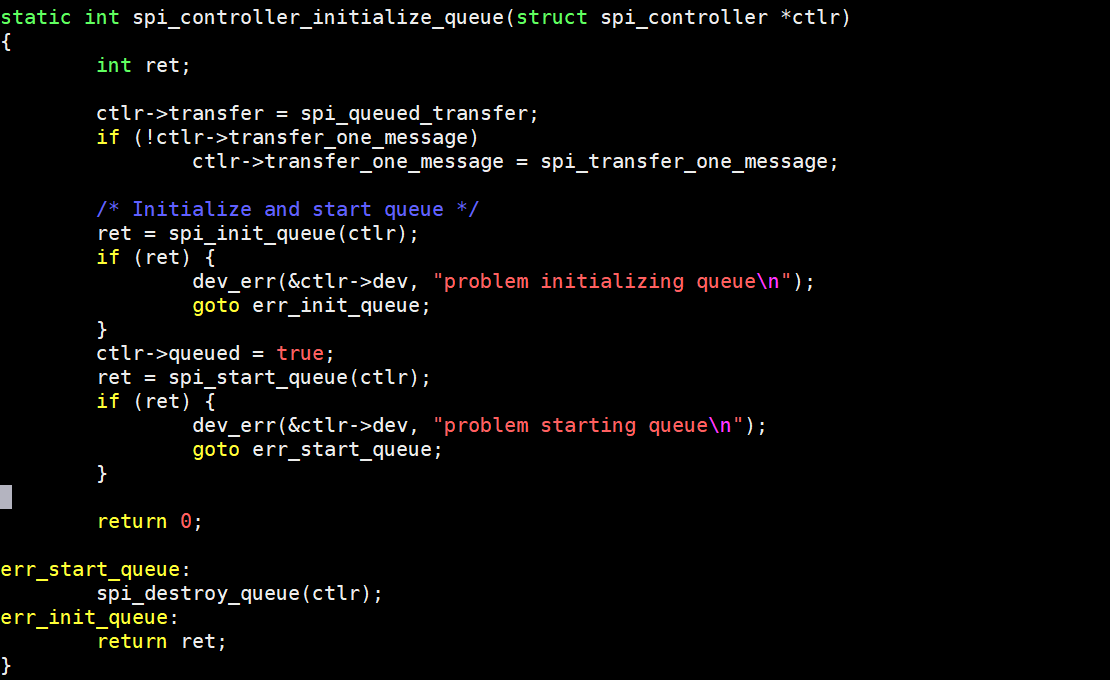
该函数主要主要:
- 先将 transfer 赋值成为 spi_queued_transfer 调用(因为只有当 transfer 没有挂指针的时候,才会走进这个函数),如果没有指定 transfer_one_message,那么为他它上SPI 核心层的 spi_transfer_one_message;这样spi_controller->transfer 和 spi_controller->spi_transfer_one_message 已经赋值为SPI核心层层的函数钩子;
- 接着调用spi_init_queue和spi_start_queue函数;
spi_init_queue
static int spi_init_queue(struct spi_controller *ctlr)
{
struct sched_param param = { .sched_priority = MAX_RT_PRIO - 1 };
ctlr->running = false;
ctlr->busy = false;
kthread_init_worker(&ctlr->kworker); // 初始化工作线程
ctlr->kworker_task = kthread_run(kthread_worker_fn, &ctlr->kworker, // 创建并启动一个内核线程来处理工作
"%s", dev_name(&ctlr->dev));
if (IS_ERR(ctlr->kworker_task)) {
dev_err(&ctlr->dev, "failed to create message pump task\n");
return PTR_ERR(ctlr->kworker_task);
}
kthread_init_work(&ctlr->pump_messages, spi_pump_messages); // 初始化kthread_work,并设置work执行函数
/*
* Controller config will indicate if this controller should run the
* message pump with high (realtime) priority to reduce the transfer
* latency on the bus by minimising the delay between a transfer
* request and the scheduling of the message pump thread. Without this
* setting the message pump thread will remain at default priority.
*/
if (ctlr->rt) {
dev_info(&ctlr->dev,
"will run message pump with realtime priority\n");
sched_setscheduler(ctlr->kworker_task, SCHED_FIFO, ¶m);
}
return 0;
}2
3
4
5
6
7
8
9
10
11
12
13
14
15
16
17
18
19
20
21
22
23
24
25
26
27
28
29
30
31
在spi_init_queue时,会初始化&ctlr->pump_messages为spi_pump_messages,其内部调用了__spi_pump_message函数。
/**
* spi_pump_messages - kthread work function which processes spi message queue
* @work: pointer to kthread work struct contained in the controller struct
*/
static void spi_pump_messages(struct kthread_work *work)
{
struct spi_controller *ctlr =
container_of(work, struct spi_controller, pump_messages);
__spi_pump_messages(ctlr, true);
}2
3
4
5
6
7
8
9
10
11
spi_start_queue
spi_start_queue函数调用比较简单,直接running状态为 true,并设置当前cur_msg 为NULL,并将pump_messages挂载工作线程kthread_worker 上,这个 work执行函就是上面设置的 spi_pump_messages。
static int spi_start_queue(struct spi_controller *ctlr)
{
unsigned long flags;
spin_lock_irqsave(&ctlr->queue_lock, flags); // 获取自旋锁,并关中断(防止中断发生,也试图获取自旋锁,造成死锁问题)
if (ctlr->running || ctlr->busy) {
spin_unlock_irqrestore(&ctlr->queue_lock, flags);
return -EBUSY;
}
ctlr->running = true;
ctlr->cur_msg = NULL;
spin_unlock_irqrestore(&ctlr->queue_lock, flags); // 释放自旋锁,并开中断
kthread_queue_work(&ctlr->kworker, &ctlr->pump_messages); // 将work加入到worker
return 0;
}2
3
4
5
6
7
8
9
10
11
12
13
14
15
16
17
18
19
spi_pump_messages

static void __spi_pump_messages(struct spi_controller *ctlr, bool in_kthread)
{
unsigned long flags;
bool was_busy = false;
int ret;
...
// spi_message结构体,spi_controller->queue链表链接着一系列spi_message
// 获取链表中的第一个spi_message结构体,每次添加时都是添加到链表末尾
ctlr->cur_msg =
list_first_entry(&ctlr->queue, struct spi_message, queue);
// 将第一个spi_message从上面的链表中删除
list_del_init(&ctlr->cur_msg->queue);
...
// 函数指针,前面已经初始化好
if (ctlr->prepare_message) {
ret = ctlr->prepare_message(ctlr, ctlr->cur_msg);
...
ctlr->cur_msg_prepared = true;
}
...
// 重要,发送,就是函数 spi_transfer_one_message
ret = ctlr->transfer_one_message(ctlr, ctlr->cur_msg);
...
}2
3
4
5
6
7
8
9
10
11
12
13
14
15
16
17
18
19
20
21
22
23
24
static int spi_transfer_one_message(struct spi_controller *ctlr,
struct spi_message *msg)
{
struct spi_transfer *xfer;
bool keep_cs = false;
int ret = 0;
unsigned long long ms = 1;
struct spi_statistics *statm = &ctlr->statistics;
struct spi_statistics *stats = &msg->spi->statistics;
...
list_for_each_entry(xfer, &msg->transfers, transfer_list) {
...
if (xfer->tx_buf || xfer->rx_buf) {
reinit_completion(&ctlr->xfer_completion);
// 其实就是,真正负责spi消息的发送
ret = ctlr->transfer_one(ctlr, msg->spi, xfer);
...
if (ret > 0) {
ret = 0;
ms = 8LL * 1000LL * xfer->len;
do_div(ms, xfer->speed_hz);
ms += ms + 200; /* some tolerance */
if (ms > UINT_MAX)
ms = UINT_MAX;
ms = wait_for_completion_timeout(&ctlr->xfer_completion,
msecs_to_jiffies(ms));
}
}
...
// 详见下
spi_finalize_current_message(ctlr);
...
}2
3
4
5
6
7
8
9
10
11
12
13
14
15
16
17
18
19
20
21
22
23
24
25
26
27
28
29
30
31
32
33
34
35
36
37
void spi_finalize_current_message(struct spi_controller *ctlr)
{
struct spi_message *mesg;
unsigned long flags;
int ret;
...
ctlr->cur_msg = NULL;
ctlr->cur_msg_prepared = false;
// 为内核worker添加一个新的处理工作,即spi_pump_message
kthread_queue_work(&ctlr->kworker, &ctlr->pump_messages);
...
mesg->state = NULL;
// 不为空则唤醒之前阻塞的线程
if (mesg->complete)
mesg->complete(mesg->context);
}2
3
4
5
6
7
8
9
10
11
12
13
14
15
16
17
18
spi_transfer_one_message
static int spi_transfer_one_message(struct spi_controller *ctlr,
struct spi_message *msg)
{
struct spi_transfer *xfer;
bool keep_cs = false;
int ret = 0;
unsigned long long ms = 1;
struct spi_statistics *statm = &ctlr->statistics;
struct spi_statistics *stats = &msg->spi->statistics;
spi_set_cs(msg->spi, true);
SPI_STATISTICS_INCREMENT_FIELD(statm, messages);
SPI_STATISTICS_INCREMENT_FIELD(stats, messages);
list_for_each_entry(xfer, &msg->transfers, transfer_list) {
trace_spi_transfer_start(msg, xfer);
spi_statistics_add_transfer_stats(statm, xfer, ctlr);
spi_statistics_add_transfer_stats(stats, xfer, ctlr);
if (xfer->tx_buf || xfer->rx_buf) {
reinit_completion(&ctlr->xfer_completion);
ret = ctlr->transfer_one(ctlr, msg->spi, xfer);
if (ret < 0) {
SPI_STATISTICS_INCREMENT_FIELD(statm,
errors);
SPI_STATISTICS_INCREMENT_FIELD(stats,
errors);
dev_err(&msg->spi->dev,
"SPI transfer failed: %d\n", ret);
goto out;
}
if (ret > 0) {
ret = 0;
ms = 8LL * 1000LL * xfer->len;
do_div(ms, xfer->speed_hz);
ms += ms + 200; /* some tolerance */
if (ms > UINT_MAX)
ms = UINT_MAX;
ms = wait_for_completion_timeout(&ctlr->xfer_completion,
msecs_to_jiffies(ms));
}
if (ms == 0) {
SPI_STATISTICS_INCREMENT_FIELD(statm,
timedout);
SPI_STATISTICS_INCREMENT_FIELD(stats,
timedout);
dev_err(&msg->spi->dev,
"SPI transfer timed out\n");
msg->status = -ETIMEDOUT;
}
} else {
if (xfer->len)
dev_err(&msg->spi->dev,
"Bufferless transfer has length %u\n",
xfer->len);
}
trace_spi_transfer_stop(msg, xfer);
if (msg->status != -EINPROGRESS)
goto out;
if (xfer->delay_usecs) {
u16 us = xfer->delay_usecs;
if (us <= 10)
udelay(us);
else
usleep_range(us, us + DIV_ROUND_UP(us, 10));
}
if (xfer->cs_change) {
if (list_is_last(&xfer->transfer_list,
&msg->transfers)) {
keep_cs = true;
} else {
spi_set_cs(msg->spi, false);
udelay(10);
spi_set_cs(msg->spi, true);
}
}
msg->actual_length += xfer->len;
}
out:
if (ret != 0 || !keep_cs)
spi_set_cs(msg->spi, false);
if (msg->status == -EINPROGRESS)
msg->status = ret;
if (msg->status && ctlr->handle_err)
ctlr->handle_err(ctlr, msg);
spi_res_release(ctlr, msg);
spi_finalize_current_message(ctlr);
return ret;
}2
3
4
5
6
7
8
9
10
11
12
13
14
15
16
17
18
19
20
21
22
23
24
25
26
27
28
29
30
31
32
33
34
35
36
37
38
39
40
41
42
43
44
45
46
47
48
49
50
51
52
53
54
55
56
57
58
59
60
61
62
63
64
65
66
67
68
69
70
71
72
73
74
75
76
77
78
79
80
81
82
83
84
85
86
87
88
89
90
91
92
93
94
95
96
97
98
99
100
101
102
103
104
105
106
107
108
这里我们就要发起传输了:
- 首先设置了片选 cs,具体调用到了芯片厂家底层对接的 set_cs
- 从 spi_message 中的 transfer_list 逐个取出 transfer 调用底层对接的 transfer_one
- 根据是否配置了需要的延时 delay_usecs,来确定是否在下一次传输之前进行必要的 udelay
- 根据是否配置了 cs_change,来判断是否需要变动片选信号 cs
- 累加实际传输的数据 actual_length
- 调用 spi_finalize_current_message 告知完成传输